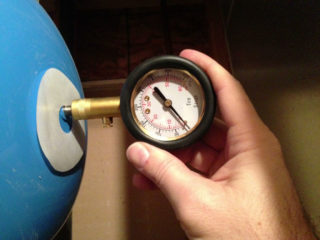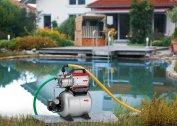The hydraulic accumulator in the water supply system is designed to maintain stable pressure. It is a sealed container with an elastic membrane. Together with a hydraulic accumulator, a pressure sensor (relay) is installed, which will automatically monitor the operation of the pump.
Why it is important to choose the right pressure
 The operation of the water supply network and the resource of the tank depend on a number of parameters:
The operation of the water supply network and the resource of the tank depend on a number of parameters:
- Proper selection of the minimum and maximum permissible air pressure at which the pump automatically switches on.
- Correct setting of the pressure level in the device.
Inside the tank there are two environments - air and water, which fills the membrane. Turning on the pump starts the water and increases the pressure. Air pushes fluid from the membrane into the pipes. After reaching the optimum value, the hydraulic accumulator is switched off. Due to the reduction in the amount of water, the pressure drops again and the pump starts up again. The hydraulic accumulator controls the air flow in the system, thereby creating optimal conditions for the functioning of the pump.
The device prevents repeated short-term starting of the pump. This allows you to maintain optimal pressure in the system. In the absence of a hydraulic accumulator, the pump motor overheats, which leads to its breakdown. With correctly set parameters and device settings, the risk of pressure drops is eliminated.
How to calculate the pressure
The air pressure in the hydraulic accumulator is set by the manufacturer. When installing the unit, you can independently calculate the optimal parameter. In this case, you need to focus on the height of the water rise. This indicator is calculated in meters.
There is a formula for calculating the indicator in the accumulator:
Ratm. = (maximum height + 6) / 10,
where is ratm. - This is the minimum allowable air pressure, and the maximum height is the highest point of water intake, measured in meters.
If the indicator is less than calculated, then the liquid will rise to the top of the water supply system. Typically, the factory settings for systems used in domestic conditions are 1-1.5 atmospheres. This indicator is independent of tank capacity. The indicator may change due to the characteristics of the membrane, which are indicated in the passport.
When using a hydraulic tank with a pump, the indicator should correspond to the lower limit for starting the pump. The limits for turning the pump on and off must be adjusted using the relay settings. It is important to ensure that the container is filled at least a third. This will prevent premature unit wear.
When self-checking and adjusting indicators, it is necessary to adhere to the recommendations indicated by the manufacturer in the instrument passport. The main rule is that the pressure in the tank should be lower than that of the pump in operating mode. The difference may be 10-12%.
A low head prevents wear on the system, but limits the use of appliances. A pressure drop below 1 bar causes the membrane to stretch. Excessive pressure increases the load on the pipe and system elements, which leads to damage.
How and how to adjust it, how often to check
 Strong pressure drops in the accumulator significantly reduce the life of the membrane. The air gradually turns into a nipple, which leads to stretching of the membrane. Because of this, it can burst. So that the unit does not fail prematurely, it is necessary to periodically take measurements of pressure using a manometer.
Strong pressure drops in the accumulator significantly reduce the life of the membrane. The air gradually turns into a nipple, which leads to stretching of the membrane. Because of this, it can burst. So that the unit does not fail prematurely, it is necessary to periodically take measurements of pressure using a manometer.
The accumulator passport contains the frequency of checks. The standard indicator is 2 times a year. Before checking the parameter, drain the water from the tank and disconnect the pump from the power supply. It is necessary to carry out control before connecting the unit to the system.
The verification procedure consists of a number of steps:
- Checking the initial pressure. It is necessary to disconnect the device from the system and drain it with liquid. Next, you need to connect the pressure gauge to the nipple and measure the pressure. It must correspond to the indicator indicated in the unit passport. If the parameter is not correct, it is necessary to pump air with a compressor.
- Validation of values in operating and off state. It is necessary to turn on the water supply and take the indicator at the time of starting the pump. After closing the tap, it is necessary to measure the indicator in the off mode.
Basic rules of adjustment:
- Turn on the tap to start the system and fill the tank with water. After that, the pressure will begin to decline until it reaches a lower value. At this moment, the relay will trip and you can remove the indicator from the pressure gauge.
- Shut off valve. The water supply will stop and the pump will continue to run. This will increase the pressure in the device. When the indicator reaches the maximum mark set for the system, the accumulator will come into effect. You need to write data again.
- The data obtained from the checks must be compared. Optimum indicators are indicated in the instrument passport.
- If the values are very different, adjust with a wrench. You will need to tighten the nut to relieve pressure. To increase the figure, loosen the nut. Repeating these steps is required until the desired parameter is reached.
Pressure control is as important as controlling water pressure. The minimum and maximum pressure indicator on the relay should be determined without errors. Exceeding the values may cause equipment damage.
The hydraulic accumulator may exit for the following reasons:
- frequent start of water;
- valve leakage;
- low pressure at the time of inlet / outlet of the liquid.
Before identifying the cause of the malfunction, the exact pressure in the pump station must be determined. If it is very abnormal, the membrane, relay or housing will be damaged. In such cases, it will be necessary to replace the damaged part. In order for the device to last for a long time, it is necessary to carry out preventive maintenance: check and adjust the mechanical elements, as well as set the pressure in the device correctly.
The device and functions of the accumulator
 The accumulator is a small box with additional elements under the lid that are responsible for its operation. The battery is attached to the outlet of the tank fitting. The mechanism is equipped with springs necessary for adjusting the nuts.
The accumulator is a small box with additional elements under the lid that are responsible for its operation. The battery is attached to the outlet of the tank fitting. The mechanism is equipped with springs necessary for adjusting the nuts.
The principle of operation of the device:
- The springs are connected to the membrane, which controls the force of pressure.
- A power-on signal is sent to the pump.
- In the process of filling the tank, the pressure increases. After that, the device deactivates the pump, giving the appropriate signal.
- In the course of spending water, the pressure becomes weaker. The system automatically starts the engine.
The liquid that has got into the container stretches the rubber membrane, forcing air out of the cavity. The pressure in the hydraulic accumulator increases
In addition, the hydraulic accumulator performs a number of functions:
- eliminates the risk of water hammer, which may occur due to rapid changes in the water supply rate;
- maintains a minimum supply of water in the device;
- controls the start and stop of the pump.


